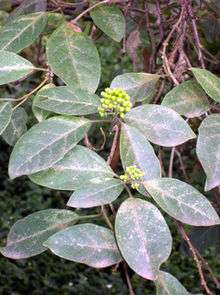Clerodendrum tomentosum
| Downy chance | |
|---|---|
 | |
| Downy chance - Denistone, New South Wales | |
| Scientific classification | |
| Kingdom: | Plantae |
| (unranked): | Angiosperms |
| (unranked): | Eudicots |
| (unranked): | Asterids |
| Order: | Lamiales |
| Family: | Lamiaceae |
| Genus: | Clerodendrum L. |
| Species: | C. tomentosum |
| Binomial name | |
| Clerodendrum tomentosum Vent., & R.Br. | |
Clerodendrum tomentosum, known as the downy chance, hairy lolly bush,[1] hairy clairy or hairy clerodendrum is a shrub or small tree occurring in eastern and northern Australia. Distributed from Batemans Bay (35° S) in southern coastal New South Wales, Queensland, Northern Territory, Western Australia, and New Guinea.[2]
The habitat is the margins of warmer rainforests[3] of various types. It can survive in certain areas of under 1000 mm average annual rainfall.
Name and taxonomy
The curious common name of downy chance refers to both the generic and species name. Clerodendrum is from the Greek. Meaning "lottery tree". Dendros meaning tree. The lottery refers to unsure possibility of medicinal value from plants of this genus. The generic name Clerodendrum was coined by the father of modern taxonomy, Carl Linnaeus. Tomentosum refers to downy or hairy leaves. Recent phylogenetic studies[4] have shown that the genus Clerodendrum belongs in the mint family. Consequently, this species is now removed from the verbena family and placed in Lamiaceae.
Description
Up to 15 metres tall with a trunk diameter of 25 cm,[5] though usually much smaller. An opened branched plant with large veiny leaves.
The trunk is mostly cylindrical or sometimes flanged at the base. Bark is grey or fawn, somewhat scaly or corky on larger plants. Young branchlets have lenticels, and are downy and soft. Angled or square in cross section, brownish grey and sometimes purple at the tips.[6]
Leaves
Opposite on the stem, without serrations, 4 to 14 cm long, 2 to 4.5 cm wide.[3] With a short tip, leaf form gradually tapering away at the base of the leaf. Upper leaf surface sometimes hairy. Hairy under the leaf, soft and downy to touch. Pale green below the leaf, darker above. Leaf veins prominent on the underside, visible on the top surface. 5 or 6 main lateral veins, curving near the leaf edge.
Flowers and fruit
White flowers form in dense heads between the months of October to January. In the form of cymes forming terminal corymbs. Four long stamens protrude from the fragrant flower.
The fruit is a black shiny or navy blue drupe with four lobes. Surrounded by a fleshy red calyx. The red and black of the fruiting body attracts birds, such as the satin bowerbird. Drupe size is 5 to 8 mm, the width of the red calyx is up to 20 mm. Flowers pollinated by nocturnal moths.[7] The fruit is not edible for humans.[8]
Slow to regenerate from seed, though it can strike from cuttings.[9]
Uses
The attractive flowers and fruit make this suitable to native gardens in Australia. A bird and butterfly attracting plant.[7] A pioneer species in regeneration areas.
References
- ↑ http://toowoombaplants2008.blogspot.com/2009/02/hairy-lolly-bush.html
- ↑ Kew World Checklist of Selected Plant Families
- 1 2 http://plantnet.rbgsyd.nsw.gov.au/cgi-bin/NSWfl.pl?page=nswfl&lvl=sp&name=Clerodendrum~tomentosum
- ↑ Cantino, P.D., Harley, R.M. & Wagstaff, S.J. 1992. Genera of Labiatae: status and classification. Pp. 511-522. In Harley, R.M. & Reynolds, T. (eds) Advances in Labiate Science. Richmond, Royal Botanic Gardens, Kew.
- ↑ Floyd, A.G., Rainforest Trees of Mainland South-eastern Australia, Inkata Press 2008, ISBN 978-0-9589436-7-3 page 172
- ↑ Floyd, A.G., Rainforest Trees of Mainland South-eastern Australia, Inkata Press 2008, ISBN 978-0-9589436-7-3 page 171
- 1 2 http://www.organicmatters.com.au/clerodend-tomentos.htm
- ↑ http://www.brisrain.webcentral.com.au/01_cms/details_pop.asp?ID=78
- ↑ http://www.lhccrems.nsw.gov.au/CPR/CPR/plant_profiles/c.tomentosum.htm
- Floyd, A.G., Rainforest Trees of Mainland South-eastern Australia, Inkata Press 2008, ISBN 978-0-9589436-7-3 page 171
- "Clerodendrum tomentosum". PlantNET - NSW Flora Online. Retrieved 2010-01-23.